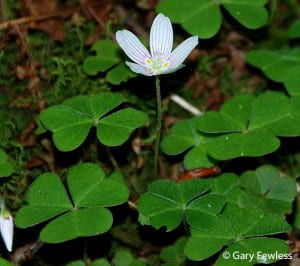Did you get a shamrock plant for Saint Patrick’s Day? It was most likely one of a few species in the genus Oxalis. Over 800 different species of Oxalis occur throughout most of the world, especially in Central America and South Africa. Their common name wood sorrel or in Europe wood sour refers to high concentrations of oxalic acid in the leaves and stems. Some are cultivated for their nutritious rhizomes, especially acta (O. tuberosa) in South America. Others like candycane sorrel (O. versicolor) and purple shamrock (O. triangularis), are prized by florists and gardeners because of their showy leaves and flowers and it is likely that you received one of these.
But is Oxalis “the” shamrock? According to Bess Lovejoy writing for Smithsonian.com, nobody is sure what plant species the stylized 3-leaved shamrock represents. Some, like 19th Century British botanist James Ebenezer Bicheno claimed that wood sorrel (Oxalis acetosella) was the “true” shamrock. Perhaps unconvinced that the British would best know which plant the Irish should call shamrock, Dublin native and amateur botanist Nathaniel Colgan decided to conduct a poll in 1892. He had people from different counties in Ireland send him specimens of shamrocks they had collected. Although there were no single winner based on his results, it seems that the Irish favor a few species of Clovers (Trifolium) especially white clover (Trifolium repens). Botanist E. Charles Nelson, repeated the study in 1988 and found similar results. Although most people selected among several species of clovers, about 5% of participants selected Oxalis as their shamrock.

White clover is common in our region especially in agricultural and other grassy open fields, however, it is not native and can be invasive, so we are choosing one of our native species of Oxalis, the northern wood sorrel (O. montana or O. acetosella f. montana), as our symbol of the season. The plants are still hunkered down as underground rhizomes, but you will be able to find these forest plants blooming throughout the western Great Lakes region in June. Look for it in boreal and mixed evergreen-deciduous forests or in northern maple beech hardwood forests.
We have several bright yellow flowered Oxalis species in WI which are somewhat associated with disturbed sites, and only two white to pale purple/rose flowered species as in O. acetosella. There is a similar species in southern WI called the violet wood sorrel (O. violacea). The two species are almost perfectly segregated geographically in the state—SW dry and sunny (violacea) versus NE moist to wet and forested (acetosella f. montana).
By Vicki Medland and Gary Fewless
Read more about the history of shamrocks in Smithsonian Magazine online: http://www.smithsonianmag.com/arts-culture/no-one-really-knows-what-shamrock-180954578/
